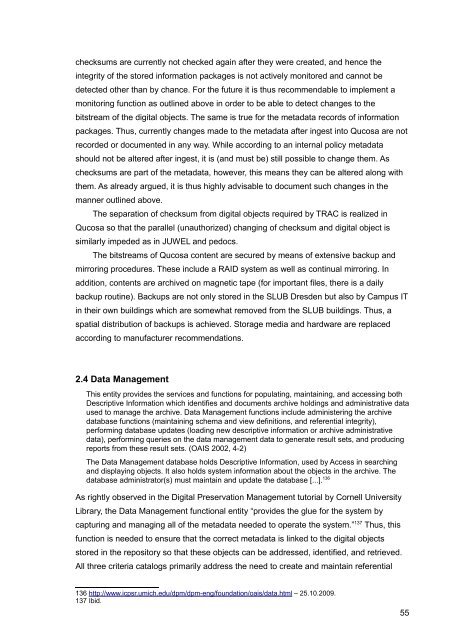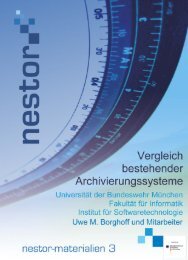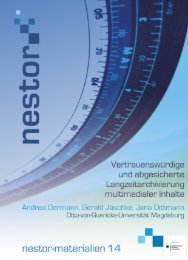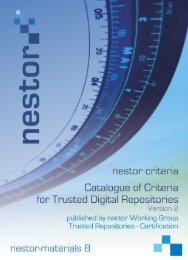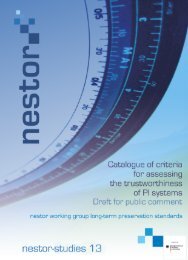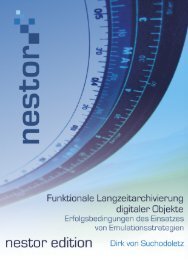Download (PDF, 9MB, Not barrier-free file.) - Nestor
Download (PDF, 9MB, Not barrier-free file.) - Nestor
Download (PDF, 9MB, Not barrier-free file.) - Nestor
- No tags were found...
You also want an ePaper? Increase the reach of your titles
YUMPU automatically turns print PDFs into web optimized ePapers that Google loves.
checksums are currently not checked again after they were created, and hence theintegrity of the stored information packages is not actively monitored and cannot bedetected other than by chance. For the future it is thus recommendable to implement amonitoring function as outlined above in order to be able to detect changes to thebitstream of the digital objects. The same is true for the metadata records of informationpackages. Thus, currently changes made to the metadata after ingest into Qucosa are notrecorded or documented in any way. While according to an internal policy metadatashould not be altered after ingest, it is (and must be) still possible to change them. Aschecksums are part of the metadata, however, this means they can be altered along withthem. As already argued, it is thus highly advisable to document such changes in themanner outlined above.The separation of checksum from digital objects required by TRAC is realized inQucosa so that the parallel (unauthorized) changing of checksum and digital object issimilarly impeded as in JUWEL and pedocs.The bitstreams of Qucosa content are secured by means of extensive backup andmirroring procedures. These include a RAID system as well as continual mirroring. Inaddition, contents are archived on magnetic tape (for important <strong>file</strong>s, there is a dailybackup routine). Backups are not only stored in the SLUB Dresden but also by Campus ITin their own buildings which are somewhat removed from the SLUB buildings. Thus, aspatial distribution of backups is achieved. Storage media and hardware are replacedaccording to manufacturer recommendations.2.4 Data ManagementThis entity provides the services and functions for populating, maintaining, and accessing bothDescriptive Information which identifies and documents archive holdings and administrative dataused to manage the archive. Data Management functions include administering the archivedatabase functions (maintaining schema and view definitions, and referential integrity),performing database updates (loading new descriptive information or archive administrativedata), performing queries on the data management data to generate result sets, and producingreports from these result sets. (OAIS 2002, 4-2)The Data Management database holds Descriptive Information, used by Access in searchingand displaying objects. It also holds system information about the objects in the archive. Thedatabase administrator(s) must maintain and update the database [...]. 136As rightly observed in the Digital Preservation Management tutorial by Cornell UniversityLibrary, the Data Management functional entity “provides the glue for the system bycapturing and managing all of the metadata needed to operate the system.” 137 Thus, thisfunction is needed to ensure that the correct metadata is linked to the digital objectsstored in the repository so that these objects can be addressed, identified, and retrieved.All three criteria catalogs primarily address the need to create and maintain referential136 http://www.icpsr.umich.edu/dpm/dpm-eng/foundation/oais/data.html – 25.10.2009.137 Ibid.55


